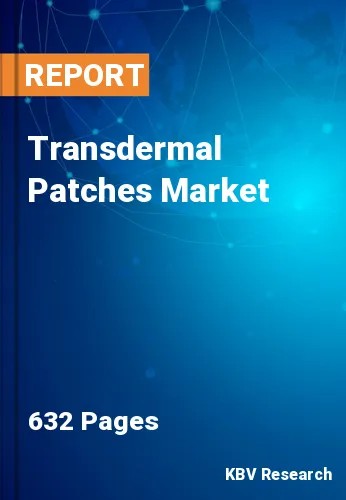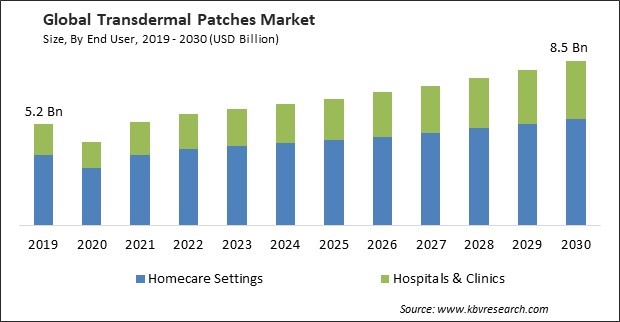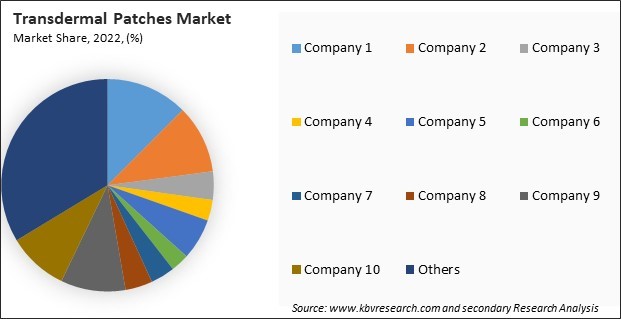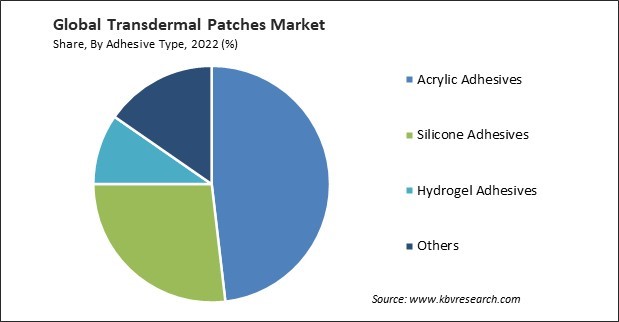
The Global Transdermal Patches Market size is expected to reach $8.5 billion by 2030, rising at a market growth of 5.1% CAGR during the forecast period. In the year 2022, the market attained a volume of 33,59,966.8 thousand units, experiencing a growth of 4.6% (2019-2022).
Cardiovascular diseases, including hypertension and angina, remain the leading causes of morbidity and mortality worldwide. Therefore, the cardiovascular disorder segment captured $413.3 million revenue in the market in 2022. The increasing prevalence of these disorders has driven the demand for innovative and efficient treatment options, positioning transdermal patches as a viable solution. Cardiovascular patients often require long-term medication to manage their conditions. These offer a convenient and patient-friendly alternative to oral medications, potentially improving patient adherence. These factors will pose lucrative growth prospects for the segment. Some of the factors impacting the market are improved patient convenience with these, growing aging population in various countries, and limited drug loading capacity.

Transdermal patches are easy to apply and can be administered by patients themselves without the need for healthcare professionals. This simplicity makes them an attractive option for individuals who prefer self-administration. Unlike oral medications or injections, these do not require water for administration or using needles. This makes them particularly convenient for patients who may have difficulty swallowing pills or who are averse to injections. In addition, these are non-invasive, eliminating the pain associated with injections and the discomfort of repeated needle use. Additionally, these are easy to apply, making them a user-friendly option for seniors with mobility or dexterity challenges. For individuals who may find it challenging to manage multiple medications with different dosing schedules, these offer a convenient way to administer drugs without the need for frequent manual dosing. Older adults may experience difficulty swallowing pills, a condition known as dysphagia. Transdermal patches eliminate the need for swallowing, providing an alternative for those who struggle with oral medication. These factors will help expand the market.
However, various patch sizes are available, and the quantity of medication that can be applied to one is limited by the surface area of the patch. Larger doses may require larger patches, and there are practical limits to how big a patch can be applied comfortably. The skin has limitations regarding the rate at which it can absorb drugs. If a patch delivers too much drug at once, it may exceed the skin's absorption capacity, leading to potential issues such as skin irritation or the inability to deliver the drug effectively. These aspects can hamper the growth of the market.
The global lockdowns, restrictions on movement, and disruptions in transportation during the early stages of the pandemic led to challenges in the supply chain for pharmaceutical products. This affected the production and distribution of transdermal patches, potentially causing delays in manufacturing and delivery. The focus of healthcare systems and professionals shifted significantly toward addressing the immediate challenges posed by the pandemic. The pandemic disrupted ongoing and planned clinical trials across various therapeutic areas. This interruption affected the development and regulatory approval of new transdermal patch products.

The leading players in the market are competing with diverse innovative offerings to remain competitive in the market. The above illustration shows the percentage of revenue shared by some of the leading companies in the market. The leading players of the market are adopting various strategies in order to cater demand coming from the different industries. The key developmental strategies in the market are Acquisitions, and Partnerships & Collaborations.
On the basis of end user, the market is bifurcated into homecare settings and hospitals & clinics. In 2022, the homecare settings segment witnessed the maximum revenue share in the market. These offer a non-invasive and convenient method of drug delivery. Patients can easily apply the patches at home without the need for healthcare professionals, reducing the necessity for frequent visits to healthcare facilities. This convenience is particularly beneficial for individuals managing chronic conditions that require continuous medication. Therefore, the segment will witness a rise in demand in the coming years.
Based on distribution channel, the market is segmented into hospital pharmacies, retail pharmacies, and online pharmacies. In 2022, the retail pharmacies segment garnered a significant revenue share in the market. Many transdermal patches, especially those used for common conditions like pain relief or smoking cessation, are available over the counter. Retail pharmacies serve as key distribution points for OTC transdermal patches, allowing consumers to purchase without needing a doctor's prescription. These factors will propel the demand in the segment.
On the basis of adhesive type, the market is divided into acrylic adhesives, silicone adhesives, hydrogel adhesives, and others. The acrylic adhesives segment recorded the maximum revenue share in the market in 2022. Acrylic adhesives are known for their strong and durable adhesion properties. In the context of transdermal patches, which require prolonged adhesion to the skin for controlled drug delivery, the excellent bonding capabilities of acrylic adhesives contribute to the overall effectiveness of the patches. Many acrylic adhesives used in these are formulated to be skin-friendly.

Based on patch type, the market is segmented into drug-in-adhesive, matrix patches, reservoir membrane patches, microneedle patches, iontophoresis patches, and vapour patches. The reservoir membrane patches segment procured a promising growth rate in the market in 2022. The reservoir membrane design allows for a more controlled and precise release of drugs. It typically consists of a drug reservoir separated from the skin by a semipermeable membrane. This membrane controls the rate at which the drug is released, resulting in a more predictable and sustained release profile.
Based on application, the market is divided into pain management, smoking cessation, hormone replacement therapy, cardiovascular disorder, central nervous system disorder, and others. The pain management segment recorded the maximum revenue share in the market in 2022. Chronic pain conditions, such as osteoarthritis, neuropathic pain, and musculoskeletal disorders, are prevalent worldwide. These offer a sustained and controlled release of analgesic medications, providing a valuable solution for patients managing long-term pain.
| Report Attribute | Details |
|---|---|
| Market size value in 2022 | USD 5.8 Billion |
| Market size forecast in 2030 | USD 8.5 Billion |
| Base Year | 2022 |
| Historical Period | 2019 to 2021 |
| Forecast Period | 2023 to 2030 |
| Revenue Growth Rate | CAGR of 5.1% from 2023 to 2030 |
| Number of Pages | 632 |
| Number of Table | 1170 |
| Quantitative Data | Volume in Thousand Units, Revenue in USD Billion, and CAGR from 2019 to 2030 |
| Report coverage | Market Trends, Revenue Estimation and Forecast, Segmentation Analysis, Regional and Country Breakdown, Market Share Analysis, Porter’s 5 Forces Analysis, Company Profiling, Companies Strategic Developments, SWOT Analysis, Winning Imperatives |
| Segments covered | Patch Type, Adhesive Type, Distribution Channel, Application, End User, Region |
| Country scope |
|
| Companies Included | Johnson & Johnson, Viatris, Inc. (Mylan N.V.), Boehringer Ingelheim International GmbH, Endo International PLC, Bayer AG, Nitto Denko Corporation, Cipla Limited, Amneal Pharmaceuticals, Inc., Novartis AG, and AbbVie, Inc. |
| Growth Drivers |
|
| Restraints |
|
By region, the market is segmented into North America, Europe, Asia Pacific, and LAMEA. In 2022, the North America segment acquired the highest revenue share in the market. North America, including the United States and Canada, is characterized by a high prevalence of chronic diseases such as diabetes, cardiovascular disorders, and chronic pain conditions. Transdermal patches provide a convenient and effective means of delivering medications for long-term management of these conditions. The rising burden of chronic diseases has contributed to the growing demand in the region.
Free Valuable Insights: Global Transdermal Patches Market size to reach USD 8.5 Billion by 2030
The market research report covers the analysis of key stake holders of the market. Key companies profiled in the report include Johnson & Johnson, Viatris, Inc. (Mylan N.V.), Boehringer Ingelheim International GmbH, Endo International PLC, Bayer AG, Nitto Denko Corporation, Cipla Limited, Amneal Pharmaceuticals, Inc., Novartis AG, and AbbVie, Inc.
By End User (Volume, Thousand Units, USD Billion, 2019-2030)
By Distribution Channel (Volume, Thousand Units, USD Billion, 2019-2030)
By Adhesive Type (Volume, Thousand Units, USD Billion, 2019-2030)
By Patch Type (Volume, Thousand Units, USD Billion, 2019-2030)
By Application (Volume, Thousand Units, USD Billion, 2019-2030)
By Geography (Volume, Thousand Units, USD Billion, 2019-2030)
Companies Profiled
This Market size is expected to reach $8.5 billion by 2030.
Improved patient convenience with transdermal patches are driving the Market in coming years, however, Limited drug loading capacity restraints the growth of the Market.
Johnson & Johnson, Viatris, Inc. (Mylan N.V.), Boehringer Ingelheim International GmbH, Endo International PLC, Bayer AG, Nitto Denko Corporation, Cipla Limited, Amneal Pharmaceuticals, Inc., Novartis AG, and AbbVie, Inc.
In the year 2022, the market attained a volume of 33,59,966.8 thousand units, experiencing a growth of 4.6% (2019-2022).
The Drug-In-Adhesive segment is generating highest revenue in the Market by Patch Type in 2022; thereby, achieving a market value of $4.2 billion by 2030.
The North America region is leading the segment in the Market by Region in 2022, and would continue to be a dominant market till 2030; thereby, achieving a market value of $3.0 billion by 2030.
Our team of dedicated experts can provide you with attractive expansion opportunities for your business.
